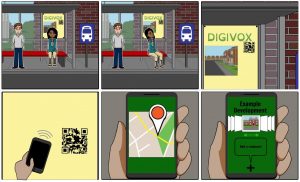Reflection log 26th Oct
Here is a summarised, detailed overview of the interviews with each interviewee: Peter Cockbait and Sheila Spencer.
________________________________________________
Interview with Peter 25.10.17
After introducing ourselves and briefing about the project we asked them to sign consent forms to allow us to record them.
Attendance: Cindy, Thomas, Rory
Who are they:
Peter Cockbain and Heather Docherty both work in the fairer housing unit in the Newcastle city council. They work on turning council-owned land to delivered housing. The council works closely with the developers when it comes to planning and public engagement. There is a large focus on accessibility and the residents well beings. They also pay a lot of attention to special minority groups.
Key problems:
–Peoples mindsets, they are often negative and have little or no belief that they can influence or make a difference in the planning process.
–Reach: They find it hard to reach out to the poorer neighbourhoods (Language and literacy issues), as well as students. Older generations and families tend to get more involved. With many groups, they mistrust towards the local authorities and feel like they are almost working against them.
–Lack of common ground for the public to express their views and opinions.
Methodology:
-They try different methods ranging from questionnaires, surveys, interactive posters, joint consultation events. Sometimes they combine these methods with bigger events as opportunities to promote and engage.
Evaluation and results:
-The participation levels vary according to the issues.
-The results are not representative of the community as a whole as there are often small vocal minority groups that speak up and create an intimidating atmosphere for participation. -The Relationship between planners and public:
It depends on the planner, their experiences and how they communicate (tone, language). -The council tends to work alongside with developers. There is social value to high engagement, it’s important to make sure that there is a common interest to help the community amongst the local authority, planners and developer.
3 wishes:
-happy residents, living in good quality housing who feel like they are heard.
-positive perception (no assumptions) where they are comfortable with the process.
-better communication, promotion.
Brainstorming of ideas in regards to opportunities using digital platforms?
-anonymous participation. A technical platform can provide consultation opportunities at low costs.
-language barriers. Social media and tablets?
_____________________________________
Interview with Sheila Spencer 26.10.17
After introducing ourselves and briefing about the project we asked her to sign a consent form to allow us to record her.
Note: Sheila has worked in the organisation for a while and can comment on the changes over the years if any.
Attendance: Cindy, Thomas.
Who:
Sheila Spencer has worked in the independent organisation, Ouseburn valley Trust, as a trustee for over 20 years and involved with community participation in the planning and projects in the area.
Experience with public engagement:
-Engagement levels vary as it depends on the projects and how it affects people.
-The perspective is still quite cynical amongst the communities.
-The way the organisation involves people has not changed drastically, but it has gotten harder to get information, as the council is possibly more hard pressed (little people). It is hard to get the information and find it.
-it is also not representative as mailing list goes to many people outside the area. People who use the area are usually quite passionate and engaged with the projects.
Other changes:
Many new accommodations of different groups of people. Those of higher socio-economic status are often more involved than the poorer neighbourhoods and new students.
students are not as invested as many don’t stay long-term, and disadvantaged and homeless groups do not trust the authorities.
Complicated process:
-The developers have to consult multiple times with the public, it is often unclear when
things get approved and informing people about it.
Key problems
–Reach: Promotion, informing and communication methods are not very efficient, mailing lists are not efficient as many don’t check. (Facebook works to some extent)
–Hard to attract people to meetings (depends on the issues)
–Poor communication between planners and community in terms of planning process, important information and updates.
Relation and communication between developer and community:
–Developers have different agendas and often mispresent things as they use CAD models instead of realistic photos. There is mistrust.
-Their language is misleading (like promising jobs, which are actually just temporary)
-Uncertainty, hard to see the actual changes, and many “invisible” amendments to plans.
-Method of engagement from developers side is sometimes successful such as using community events, stalls to increase participation, or using a facility and inviting people.
Limitations to developers methods to engage the public:
-Developers tend to develop the questionaries’ with can use misleading or confusing language. It ends up supporting their views (motives).
3 wishes:
-Would like to see developers increase their reach and circulate to more people in more ways. Better promotion to reach people using clear (non-formal, legal) language and increased visibility (bigger posters).
–Developers setting up events. Ideal: independent facilitators to engage people (reduce bias)
-More approachable and accessible material from planner: Improved design, layout and graphics of planning sites so that documents become easier to navigate. They also want to be better informed and updated about the most recent changes, amendments. (be more clear in the 2nd round of planning).
__________________________________
In both interviews, we experienced similarities in the responses regarding the engagement and that both stakeholders shared the key problem of reach, and increasing the engagement of the public. They both expressed the difficulty in changing the perception of the community.
